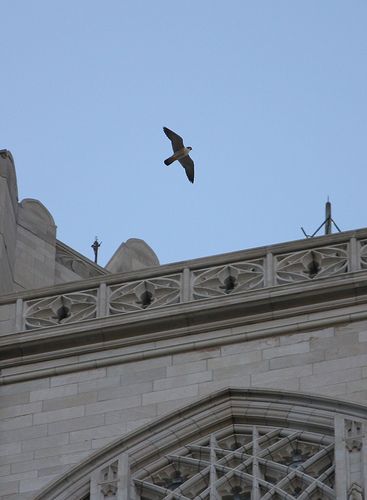 The young peregrines at the University of Pittsburgh are flying and doing well. Sometimes they play games in the air, chasing each other and pretending to exchange food. They also chase their parents.
The young peregrines at the University of Pittsburgh are flying and doing well. Sometimes they play games in the air, chasing each other and pretending to exchange food. They also chase their parents.
Needless to say Dorothy and E2 are busy trying to keep the “kids” fed.
Steve Valasek captured this photo of Dorothy on Sunday as she checked on their whereabouts.
And this morning Jack and Sue Solomon saw one of the adults (I’ll bet it was E2) at Duck Hollow on the Monongahela River, plucking a meal as he flew toward the Cathedral of Learning.
Busy, busy!
The youngsters are still staying close to home so you’re likely to see them if you come to campus.
Check the lower roof edges of the Cathedral of Learning or the steeple on Heinz Chapel and you’ll probably find a peregrine.
.
p.s. June 9, 2:00pm: The juveniles were perched on both steeples of St. Paul’s Cathedral. They’re widening their range.
June 11, 8:30am: Four juveniles have been hanging out at St. Paul’s Cathedral, Webster Hall and an apartment building nearby — seen yesterday at lunch and this morning before work.
(photo by Steve Valasek)
Beautiful!!
Thanks for the update! Maybe I will make another road trip.
Thanks for the update, Kate. I appreciate knowing what is going on.
In addition to feeding the full-sized juvies, Dorothy and E2 have to be on their toes (talons? 🙂 ) in keeping track of where the youngsters are located!
Great pic, Steve!
Thank you for the update. Miss watching them at the COL. All grown up and flying. Hopefully they will fly by down here in Washington County. I keep looking up looking for them to swoop by.
What a beautiful picture, thank you for sharing.
If anyone is interested in seeing newborn chicks & are starting to have withdrawal pains or missing the COL chicks you can go to http://www.falconcam.med.ualberta.ca/index.html. The chicks there just hatched over the weekend so you can watch them grow up. There are 3 camera views-inside the nestbox, front of the nestbox & side view. You can probably even see them fly once they are old enough since you can see the front & top of the nextbox from the 1 camera view.
Saw two of the Pitt fledgelings flying around St. Paul’s this morning as I came in to work. 🙂
As soon as the falcons begin to fly at the GT, I will be going through a falcon withdrawal. Will have to wait until next year. Will miss those little ones that we got to know and loved.
The fledglings must like St Paul… because we saw them again today around 11am. One was squawking to beat the band for a while and then found a better (higher) vantage point on one of the towers. Saw a sibling… flew off… and both were spotted around 11:45 on top of Webster Hall having a bit of lunch! I think the 3rd was a parent… not really sure how to tell, but it was not engaging in much eating and flew off before the other 2 were finished. Kate, how can we amateur falcon watchers tell the difference between parent and fledge at this point? thanks for your answer…
this has been such an exciting and rewarding couple weeks! I agree with Carol… I’ll miss those little guys!
Kate – looked at your FAQ and found my answer about what to look for between Parent and Offspring. I saw 1 adult and 2 children on Webster Hall.
Question: The young peregrines seem to be a different color than their parents. How long does this color difference last?
Answer: Here’s a good side-by-side comparison of an adult and juvenile peregrine falcon. This happens to be a mother peregrine and her youngster from Wilmington, Delaware, both photos by Kim Steininger.
The adult female on the left has charcoal gray-and-white plumage. Her chest and throat are white or rosy-white. Her belly is white with horizontal dark gray stripes and the insides of her wings are striped like her belly – but more so. Her back and head are charcoal gray. The cere (the skin on her face near her beak) and the skin around her eyes are both yellow. Her legs are a very bright yellow.
Compare this to her offspring whose plumage is dark brown and cream-colored. The youngster (I’m guessing it’s a female) has a dark brown head and back. Her belly, throat and the insides of her wings are striped brown and cream. The stripes on her belly are vertical instead of horizontal. Her cere is pale gray and her legs are pale yellow.
I need a camera! 5:10 pm friday. 3 peregrine (were 4) on one church steeple!!!